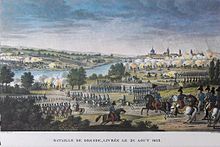
Back معركة دريسدن Arabic Batalla de Dresde AST Bitva u Drážďan Czech Schlacht um Dresden German Μάχη της Δρέσδης Greek Batalo de Dresdeno Esperanto Batalla de Dresde Spanish Bataille de Dresde French קרב דרזדן HE Drezdai csata Hungarian
| Battle of Dresden | |||||||
|---|---|---|---|---|---|---|---|
| Part of the German campaign of the War of the Sixth Coalition | |||||||
 Battle of Dresden by Carle Vernet and Jacques François Swebach | |||||||
| |||||||
| Belligerents | |||||||
|
|
| ||||||
| Commanders and leaders | |||||||
|
|
| ||||||
| Strength | |||||||
|
100,000[1] 135,000[2] |
200,000[1] 215,000[2] | ||||||
| Casualties and losses | |||||||
| 10,000 killed or wounded[1] |
38,000[2] 14,000 killed or wounded, 24,000 captured, 40 guns | ||||||
Location within Europe | |||||||
The Battle of Dresden (26–27 August 1813) was a major engagement of the Napoleonic Wars. The battle took place around the city of Dresden in modern-day Germany. With the recent addition of Austria, the Sixth Coalition felt emboldened in their quest to expel the French from Central Europe. Despite being heavily outnumbered, French forces under Napoleon scored a victory against the Army of Bohemia led by Generalissimo Karl von Schwarzenberg. However, Napoleon's victory did not lead to the collapse of the coalition, and the weather and the uncommitted Russian reserves who formed an effective rear-guard precluded a major pursuit. Three days after the battle, the Allies surrounded and destroyed a French corps advancing into their line of withdrawal at the Battle of Kulm.
- ^ a b c d Bodart 1908, p. 455.
- ^ a b c Leggiere 2015, p. 9.

